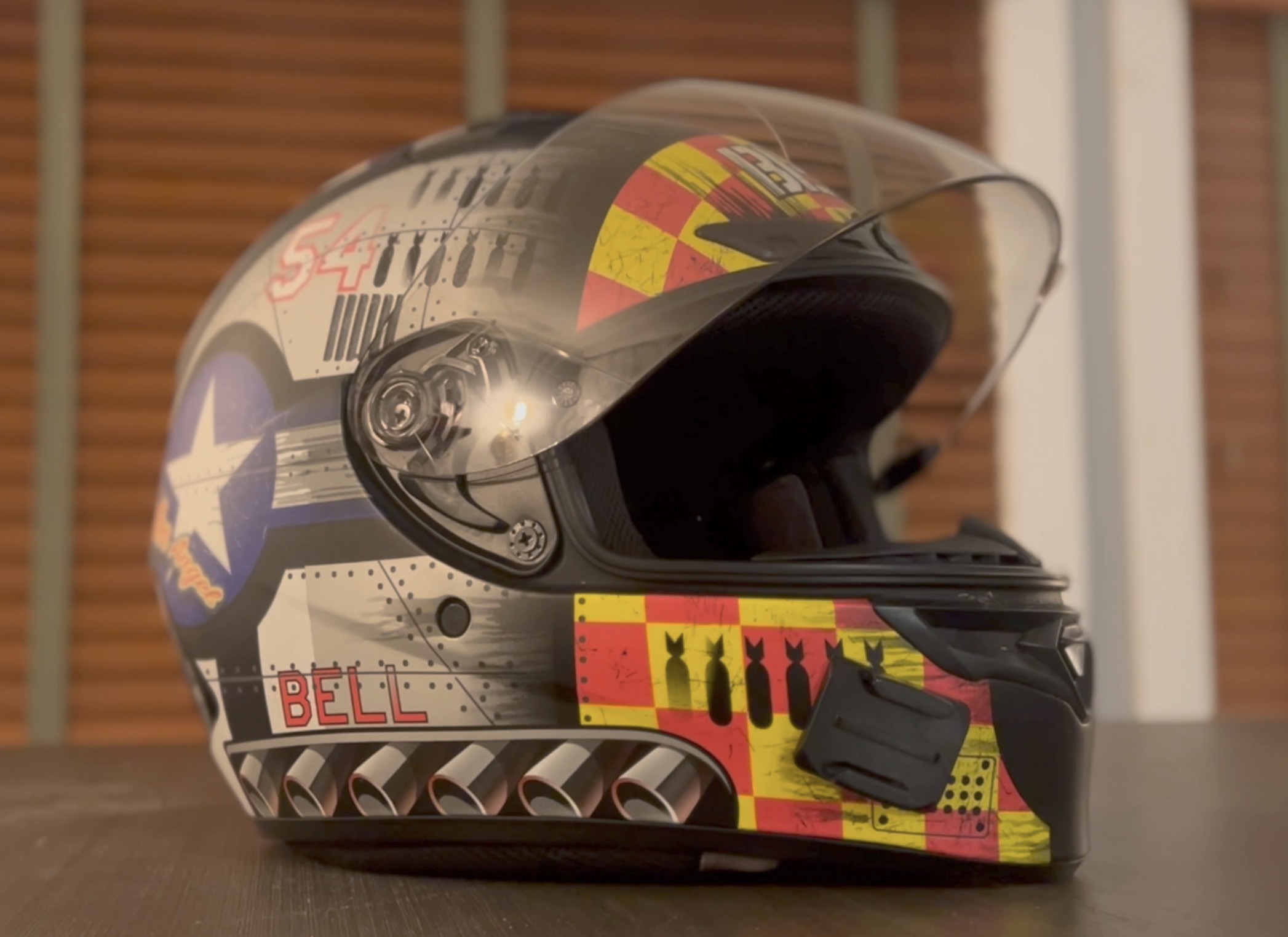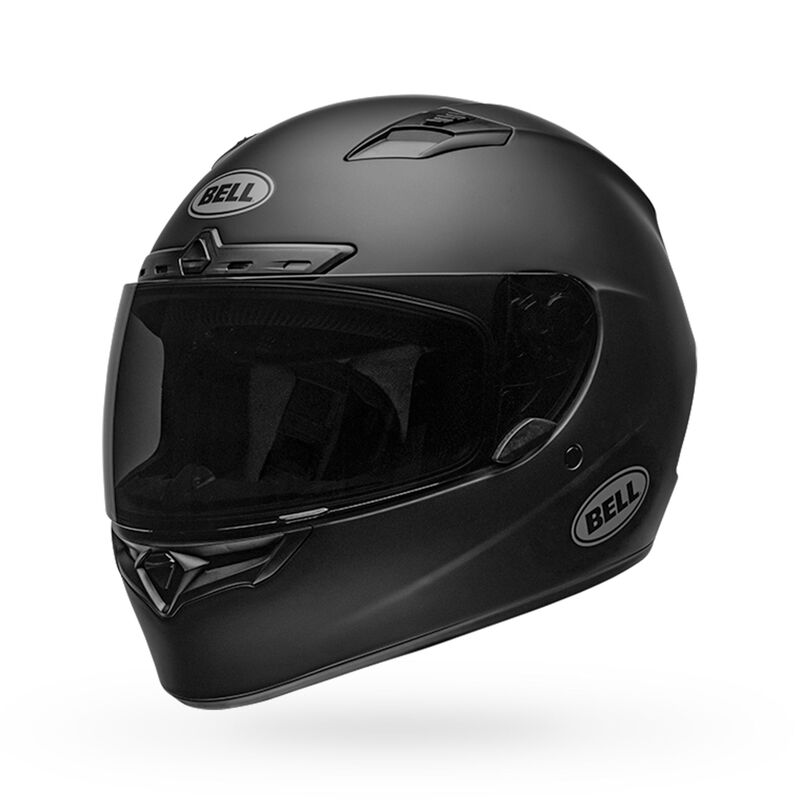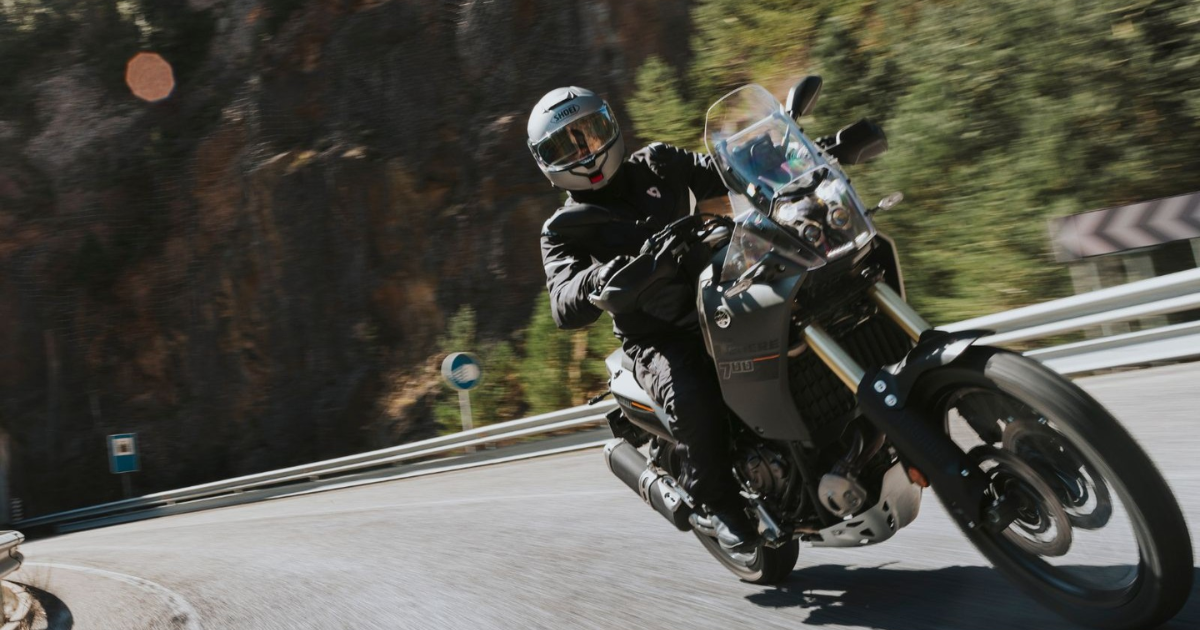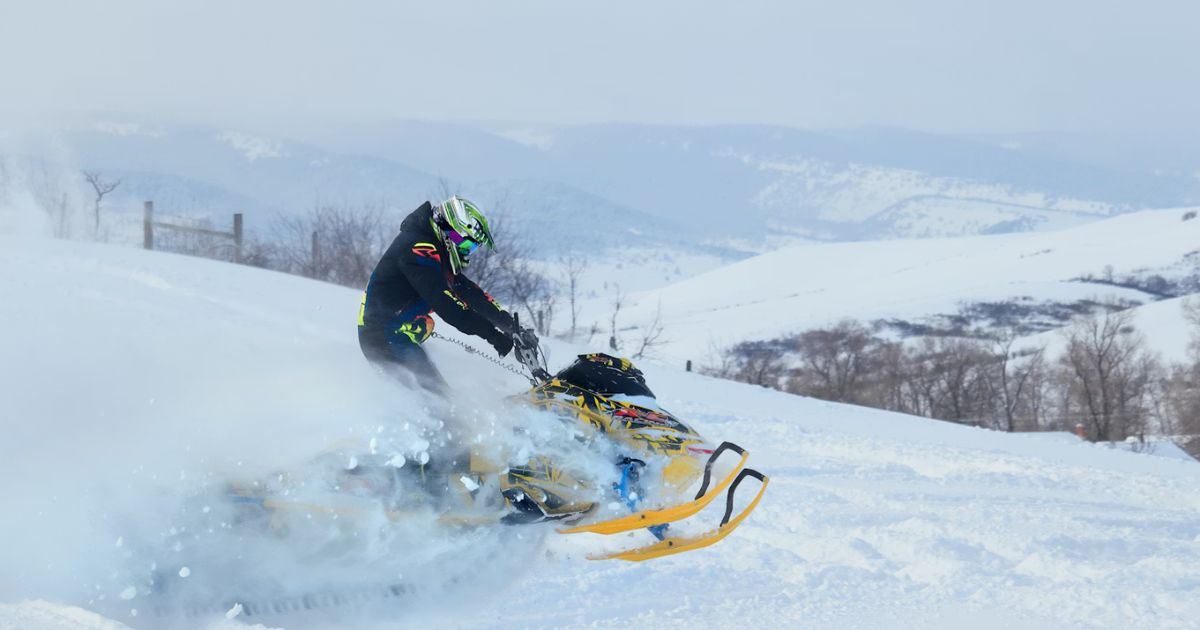
Shoei RF-1400 vs Bell Qualifier DLX MIPS: Street & Sport Touring
left for contents
You’ve probably noticed these two helmets pop up in very different conversations.
The Shoei RF-1400 is the refined heir to the much-loved RF-1200—Shoei spent serious time in the wind tunnel to make it one of the quietest, most comfortable helmets you can wear all day.
On the other side, the Bell Qualifier DLX MIPS is all about packing in modern safety tech and a trick photochromic shield, but at a price that won’t make your wallet groan. So which one should you throw on for your next ride?
Let’s break it down—who each helmet suits best, what riders say, and if the Shoei’s extra ~$400 is really money well spent.
Quick Verdict at a Glance
Who should buy the Shoei RF‑1400
- Riders who value a quiet helmet and are willing to pay for it. Reviews consistently praise the RF‑1400’s wind‑tunnel‑developed shell and new airtight shield seal for its class‑leading noise reduction. If you ride long hours at highway speeds or use a communicator, the quietness reduces fatigue.
- Touring and sport‑touring riders who need a helmet that works across seasons. Six intake and four exhaust vents, plus a Pinlock Evo insert and breath guard, make the Shoei comfortable in humid summers and well sealed in cold rain. Five shell sizes allow a comfortable, balanced fit from XS to 3XL.
- Riders who prioritize top‑tier safety and materials. The RF‑1400 uses Shoei’s hand‑laid Multi‑Ply Matrix AIM+ shell and dual‑density EPS liner, carries Snell M2020D and DOT approvals, and includes extras like a chin curtain and emergency cheek‑pad release.
One of the top motorcycle helmets for street riding due to its incredible safety ratings, solid build construction, versatile shell for street and track riding, and reasonable price. Long term review here.
- Staff pick at Revzilla
- Quietest helmet on the market
- Excellent build quality
- Thick noise-sealing cheekpads
- Visor seal built like Fort Knox
- Snell certified for track use
- Lacking touring comfort features like drop down sun shield
Who should buy the Bell Qualifier DLX MIPS
- Budget‑conscious riders who still want advanced safety tech. Bell integrates the MIPS rotational‑impact system and ECE 22.05/DOT certifications, rare at its price. It’s a good entry point for riders upgrading from basic lids.
- Commuters who ride mostly in warm weather. The helmet’s airflow is generous—even more than you might want in winter—and the ProTint photochromic shield eliminates visor swapping.
- Riders who want a low‑cost lid with convenience features like an included photochromic shield, integrated speaker pockets and easy ClickRelease shield swaps.
With Mips force-reduction safety tech and a photochromatic visor that changes with the sun, this lid punches way above it's budget weight class.
- Excellent airflow keeps you cool on hot rides
- MIPS adds enhanced rotational impact protection
- Photochromic visor adapts to changing light
- Comfortable liner, easy to wash and adjust
- Noticeable wind noise, especially above highway speeds
- Feels cold in low temps due to strong ventilation
The Shoei costs roughly $410 more on average than the Bell (street prices around $680–760 vs $240–270). That premium buys Snell‑rated composite construction, extremely low noise, a five‑year warranty and superior build quality. If quietness and all‑day comfort matter more than cost, the RF‑1400 is worth it.
If your budget is tight or you ride mostly short commutes and want MIPS and a photochromic shield for under $300, the Qualifier DLX MIPS offers unbeatable value.
Specs & Street Prices Side-by-Side
| Specs | Shoei RF‑1400 | Bell Qualifier DLX MIPS |
|---|---|---|
| Weight | ~3.64 lb in size M (one of the lightest Snell‑approved full‑face helmets; reviewers measured ~3.62 lb) | ~3.57 lb (polycarbonate shell; some reviews list ~3.3–3.6 lb) |
| Fit/Shape | Intermediate oval; five shell sizes (XS–3XL) for proper proportion | Intermediate oval; three shell sizes covering XS–3XL; runs slightly small |
| Shell/Materials | Multi‑Ply Matrix AIM+ (fiberglass & organic fibers) with dual‑density EPS liner | Injection‑molded polycarbonate shell with MIPS rotational‑impact liner |
| Safety/Certifications | Snell M2020D & DOT; emergency cheek‑pad removal; chin curtain included | DOT & ECE 22.05 (3‑star SHARP rating); MIPS reduces rotational forces |
| Ventilation/Weatherproofing | Six intake vents (including enlarged chin and central forehead vents) and four exhaust ports; CWR‑F2 shield with vortex generators and airtight window beading for wind‑/water‑proof seal | Adjustable chin and crown vents with large exhaust ports; airflow strong for summer but can let cold air in even when closed |
| Visor & Sun Shield | CWR‑F2 shield; Pinlock Evo anti‑fog lens included; no drop‑down sun visor (needs tinted shield) | ProTint photochromic shield adapts to light automatically; NutraFog II anti‑fog coating; ClickRelease quick‑swap mechanism |
| Comms‑Ready | Large cheek‑pad cutouts and removable ear pads allow aftermarket Bluetooth installation; included chin curtain and breath guard reduce noise | Integrated speaker pockets accommodate Sena/Cardo units; installation simple though wire channels are lacking |
| Warranty | 5 years (Shoei warranty) | 5 years (Bell warranty) |
| Street Price (typical as of Aug 2025) | $679.99–759.99 depending on color/graphic | $239.96–269.96 (often discounted under $250) |
Which Helmet Fits Your Ride?
Choose the Shoei RF‑1400 if…
- You’re sensitive to wind noise. Multiple reviewers, including long‑term owners on our site, call the RF‑1400 the quietest full‑face helmet they have worn. The wind‑tunnel‑shaped shell, new window beading and voluminous cheek pads create a seal that keeps turbulence out.
- You ride long distances or at high speeds. At around 3.6 lb, the RF‑1400 is light for a Snell‑rated helmet and the weight is evenly distributed, reducing neck fatigue on multi‑hour rides. Its aerodynamic stability and integrated spoiler keep the helmet planted even in crosswinds.
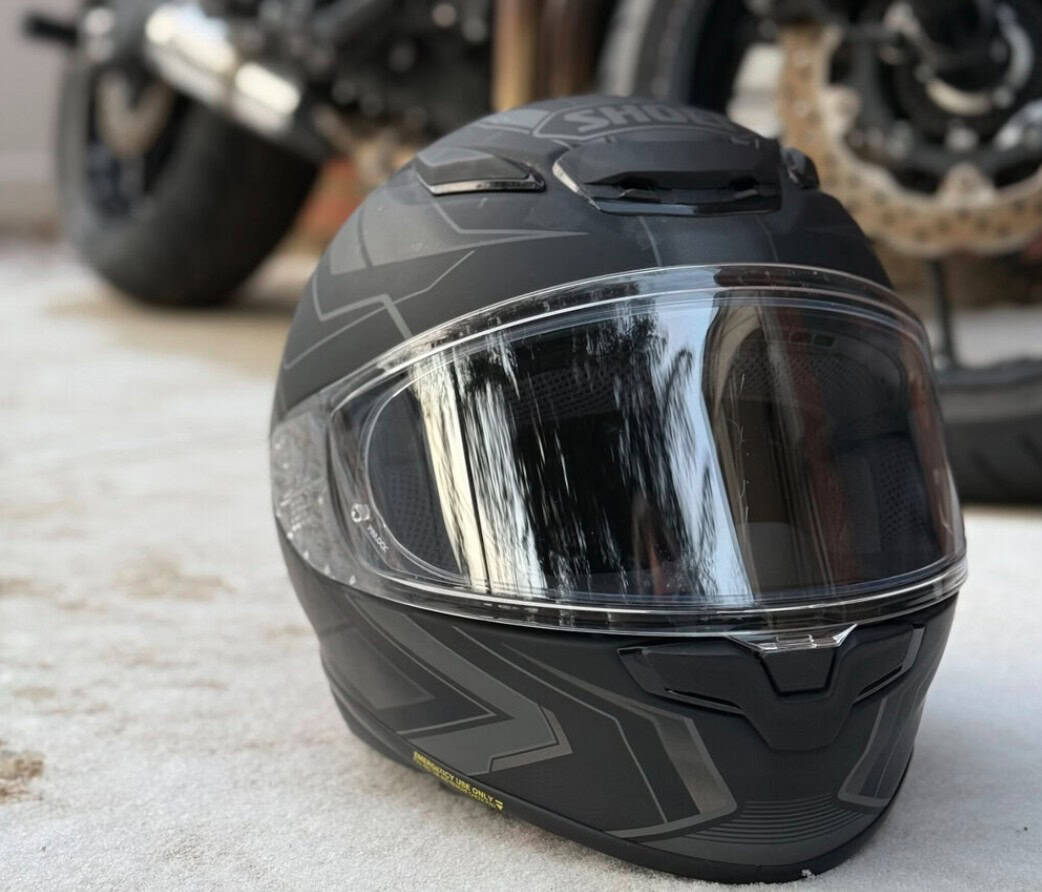
- Safety is non‑negotiable. Snell M2020 certification, Multi‑Ply Matrix AIM+ shell and dual‑density EPS provide impact and penetration protection beyond DOT requirements. Emergency cheek‑pad releases add an extra layer of safety.
- You ride in diverse climates. The RF‑1400’s six intake and four exhaust vents deliver high airflow in summer and can be closed completely in winter. A Pinlock Evo insert eliminates fogging, and a thick breath guard and chin curtain help in rain or cold.
- You prioritize premium fit and finish. Five shell sizes ensure proportional outer dimensions; the removable 3D Max‑Dry liner and cheek pads feel plush and break in over time while wicking sweat.
We’ve done a deep dive into this lid before—check out our Shoei RF-1400 review for a four-year owner’s perspective on noise, comfort, and durability.
Choose the Bell Qualifier DLX MIPS if…
- You’re on a budget but want modern safety. The helmet’s polycarbonate shell isn’t exotic, but the integrated MIPS layer reduces rotational forces, and the helmet meets DOT and ECE 22.05 standards. Few sub‑$300 helmets include this tech.
- You ride mostly in warm weather. Owners note that ventilation is impressive—chin and crown vents provide strong airflow even at moderate speeds and keep you cool up to ~85 °F. In winter this can be too much, but if you ride in a tropical climate, the breezy feel is welcome.
- You want a built‑in sun‑shield solution. Bell’s ProTint shield transitions from clear to dark automatically, eliminating the need for sunglasses or swapping visors. ClickRelease lets you change shields without tools.
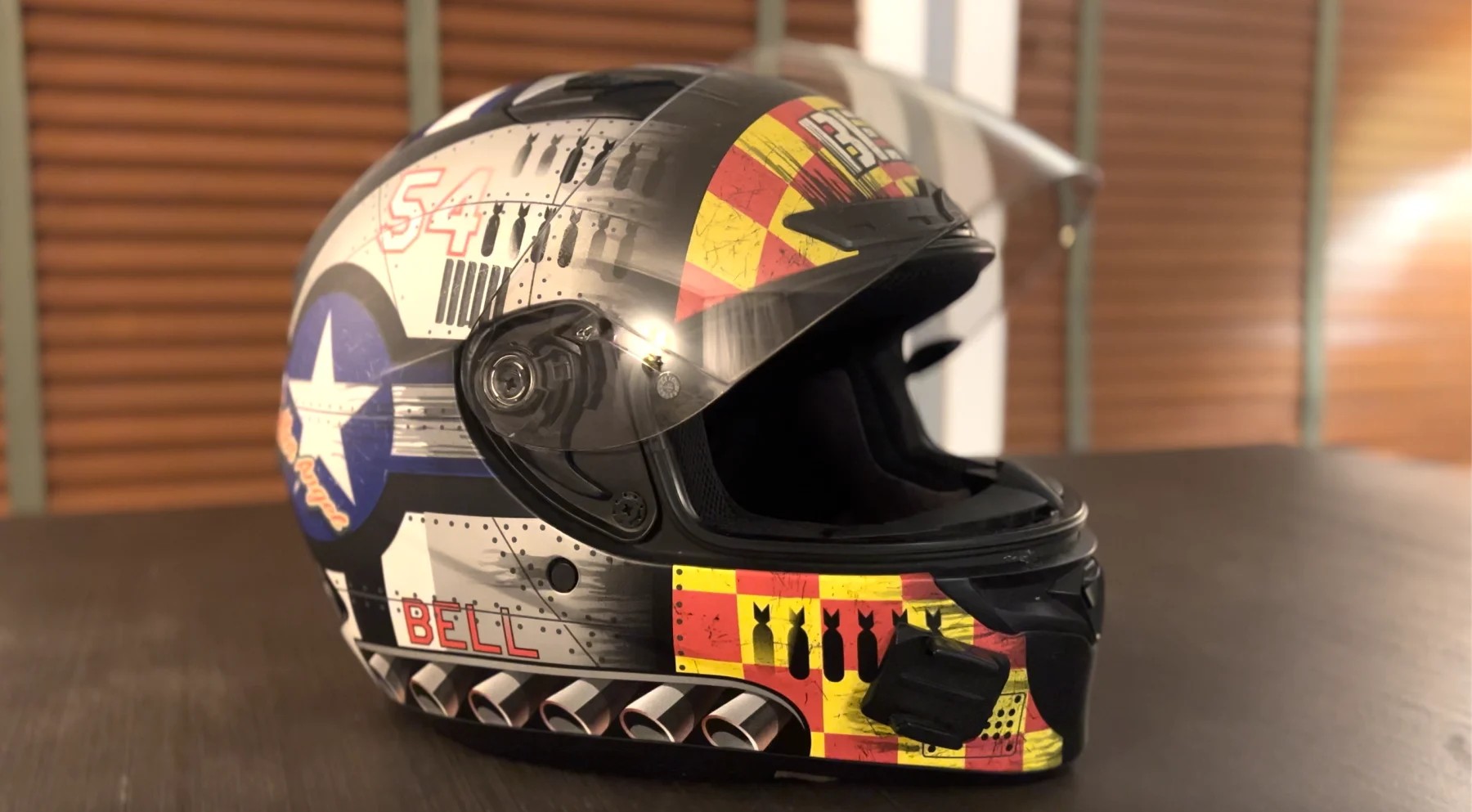
- Weight balance matters. Even though the helmet weighs roughly 3.5 lb, reviewers and our own testers report balanced weight distribution and minimal neck strain on multi‑hour rides.
- You need integrated comms pockets on a budget. The interior has speaker cutouts for Sena or Cardo units; installation is straightforward.
- You accept higher noise and less insulation. The padded wind collar helps but many riders describe the Bell as noisy at highway speeds. If you ride mostly at city speeds or wear earplugs, this may be acceptable.
If you want the full story, our Bell Qualifier DLX MIPS review covers its strengths and quirks in detail.
On the Road: Rider Impressions
Shoei RF‑1400
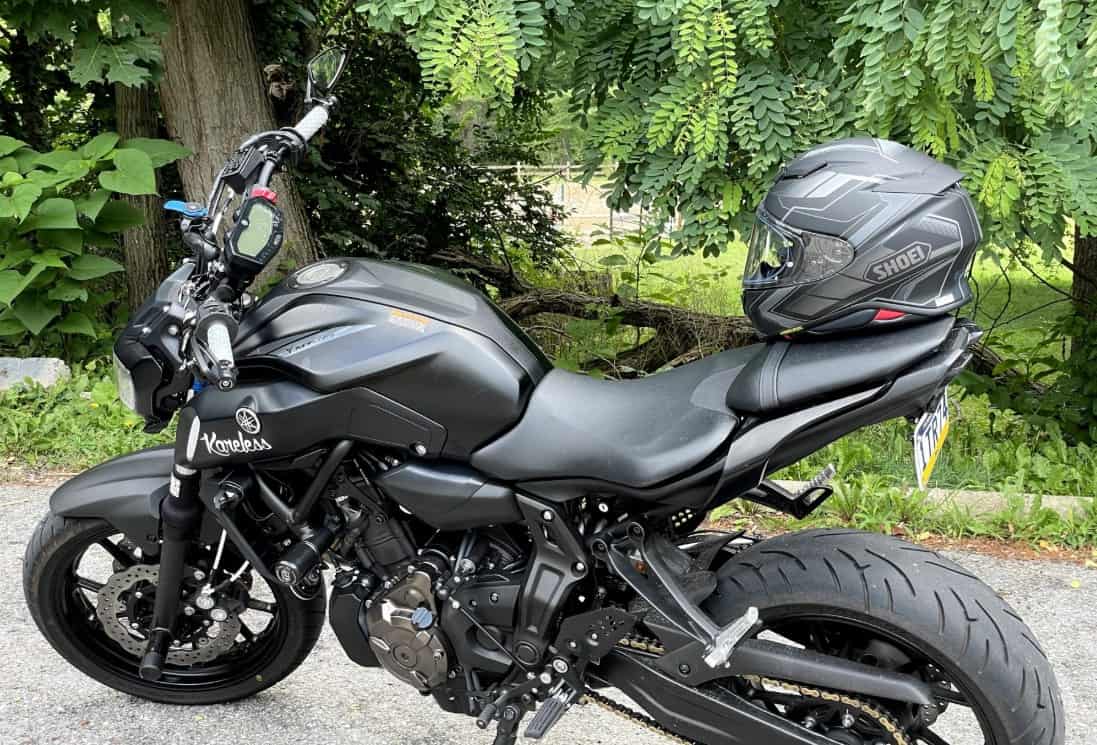
- Owner reviews and long-term tests highlight what the marketing leaves out.
- RF-1400 riders consistently praise its quiet ride and all-day comfort.
- A Women Riders Now tester noted the 3.62-lb weight feels comfortable even in heat, and praised the airtight shield seal and spoiler that reduces drag.
- Our own four-year review calls it “the quietest helmet on the market”, with interior materials that still feel plush after thousands of miles.
- Some owners say the fit is snug at first, but it breaks in within a week or two.
- With five shell sizes, the helmet avoids looking or feeling bulky across different head sizes.
Bell Qualifier DLX MIPS
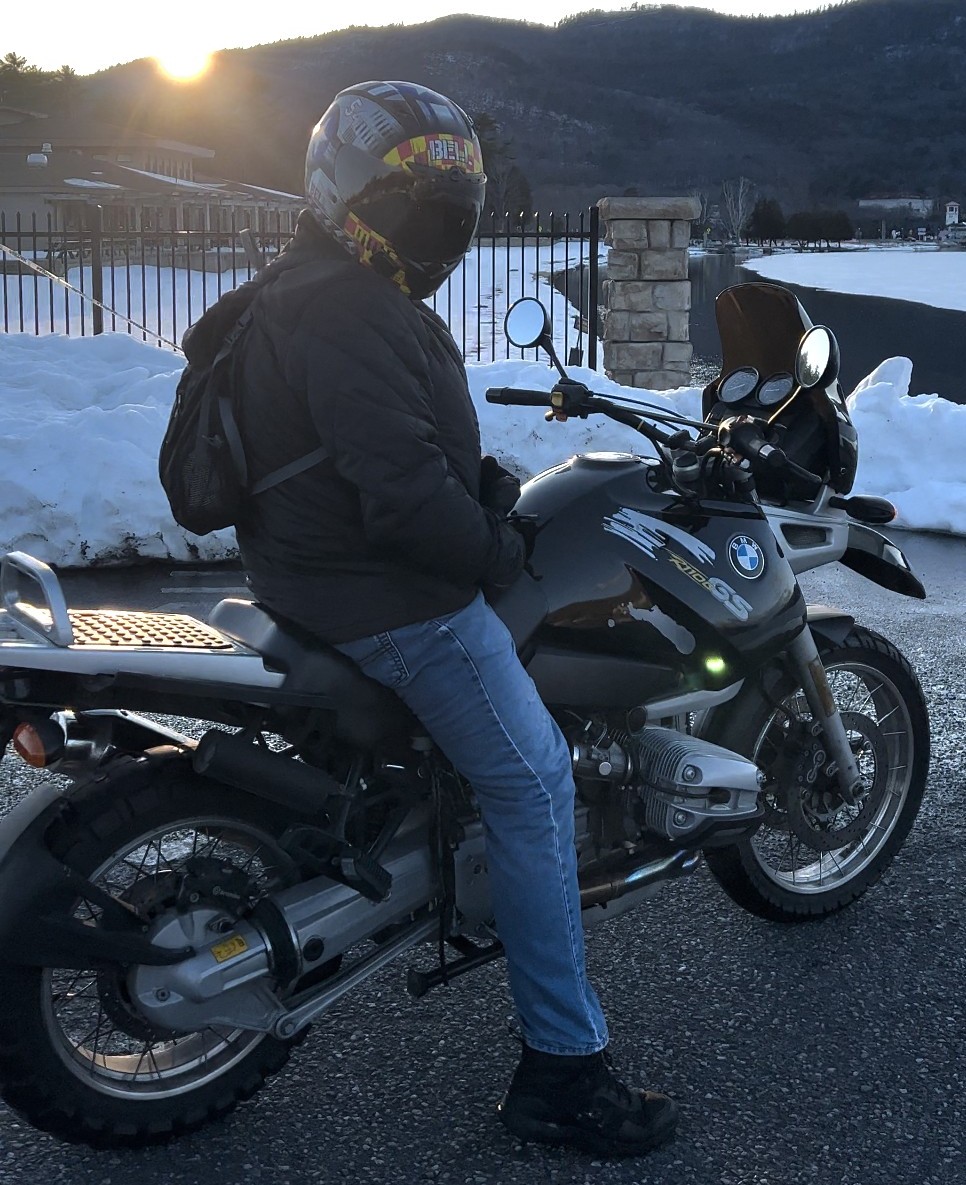
- Riders consistently highlight the value-for-money and feature set of the Qualifier DLX MIPS.
- Our Armchair Bikers team reports the 3.57-lb shell feels well balanced and doesn’t cause neck fatigue on longer rides.
- The ProTint photochromic shield earns praise for convenience, though several owners note it scratches easily if not handled with care.
- Ventilation is strong in summer, keeping riders cool, but the same airflow means cold air creeps in during winter or rain, even with vents closed.
- Noise is the most common drawback—above ~65 mph, it’s described as one of the noisier helmets in its class.
- The MIPS liner integrates seamlessly, not affecting fit while adding peace of mind on safety.
- Some owners mention the visor mechanism loosens over time, losing a bit of tension.
Category Showdown: Feature by Feature
Noise at highway speeds
The RF‑1400 is engineered for quiet. Shoei redesigned the CWR‑F2 shield base plate and window beading to create a tight wind‑ and waterproof seal. The shell’s integrated spoiler and Vortex Generator edges redirect airflow around the helmet, while thick cheek pads and a chin curtain block noise from below. Riders consistently praise the resulting quietness—even at 75 mph—allowing music or intercom conversations without turning up the volume. Earplugs are still a good idea for hearing health, but the RF‑1400 keeps wind roar to a minimum.
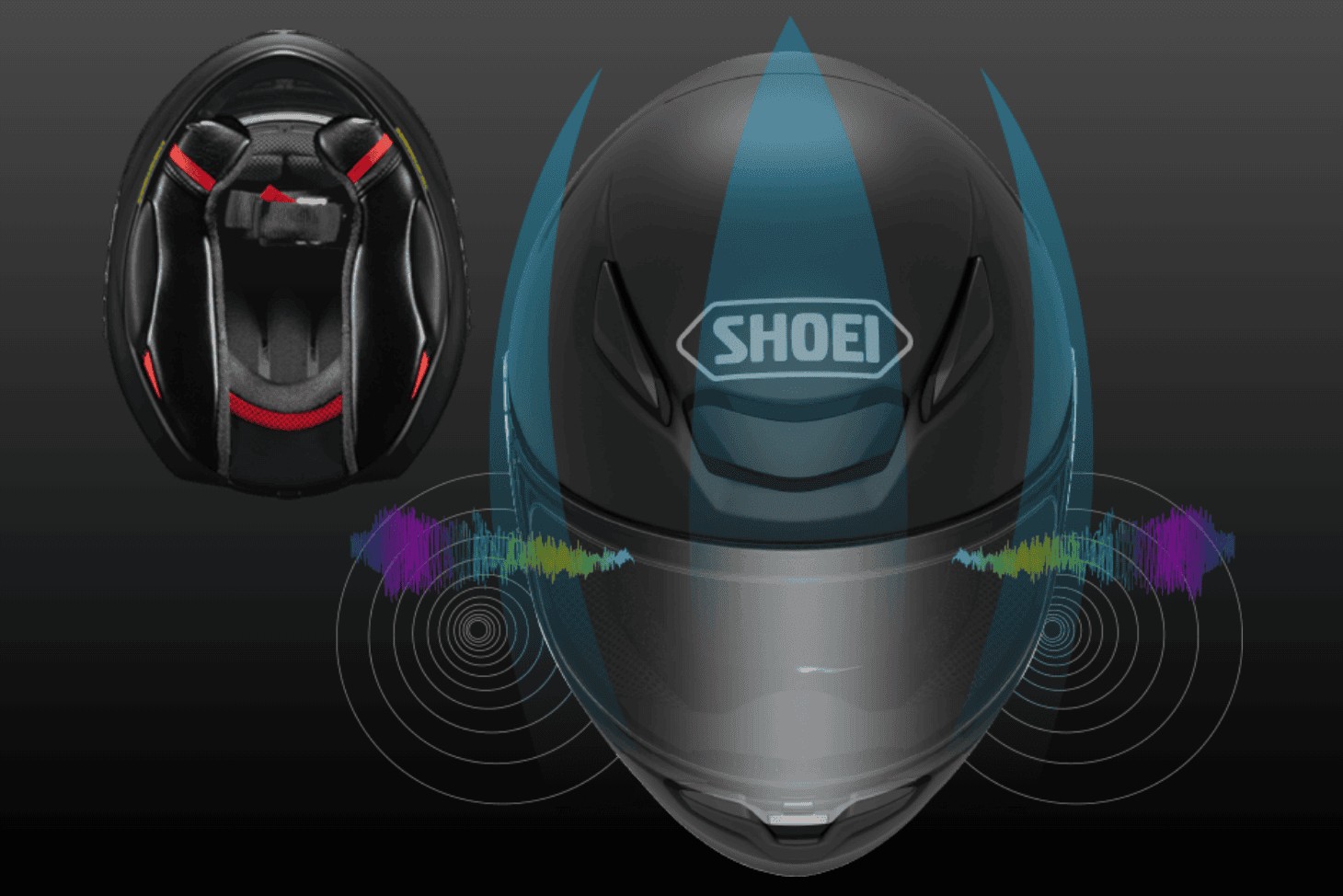
By contrast, the Qualifier DLX MIPS struggles with noise. Its polycarbonate shell lacks the dense layers of the Shoei, and the padded wind collar doesn’t maintain a seal above about 65 mph. Many riders note they must wear earplugs on highway rides. If your rides involve lots of freeway miles or you value a quiet ride, this is a significant drawback.
Weight & fatigue
Although both helmets are fairly light, the RF‑1400’s composite construction gives it an edge. At roughly 3.6 lb, it’s one of the lightest Snell‑certified full‑face helmets. Its weight is evenly distributed thanks to five shell sizes, which reduces neck strain on long tours.
The Bell weighs around 3.5 lb. The difference is small, but a few riders note that the Shoei feels lighter on the head because of its balanced fit; the Bell’s large shell size for XL‑3XL can feel bulkier. However, both helmets are manageable for all‑day use—especially compared to older polycarbonate lids.
Ventilation & hot‑weather comfort
Shoei equipped the RF‑1400 with six intake vents (including a redesigned center forehead vent and chin vent) and four exhaust ports. Channels in the dual‑density EPS liner distribute the incoming air evenly, and riders say the helmet stays comfortable even in triple‑digit heat. The vent switches are glove‑friendly and the vents can be completely closed in cold weather, keeping out drafts and rain. A Pinlock Evo insert is included to prevent fogging.

The Qualifier DLX MIPS also offers adjustable chin and crown vents, but the system is less sophisticated. Riders report good airflow above about 30 mph and effective fog prevention at the chin vent. However, the vents don’t seal as tightly; cold air can creep in around the shield and neck even when closed. In warm climates this makes the Bell pleasant, but in colder weather you’ll need a balaclava. The exhaust ports are reasonably effective at pulling out warm air, but the helmet doesn’t match the Shoei’s cooling efficiency.
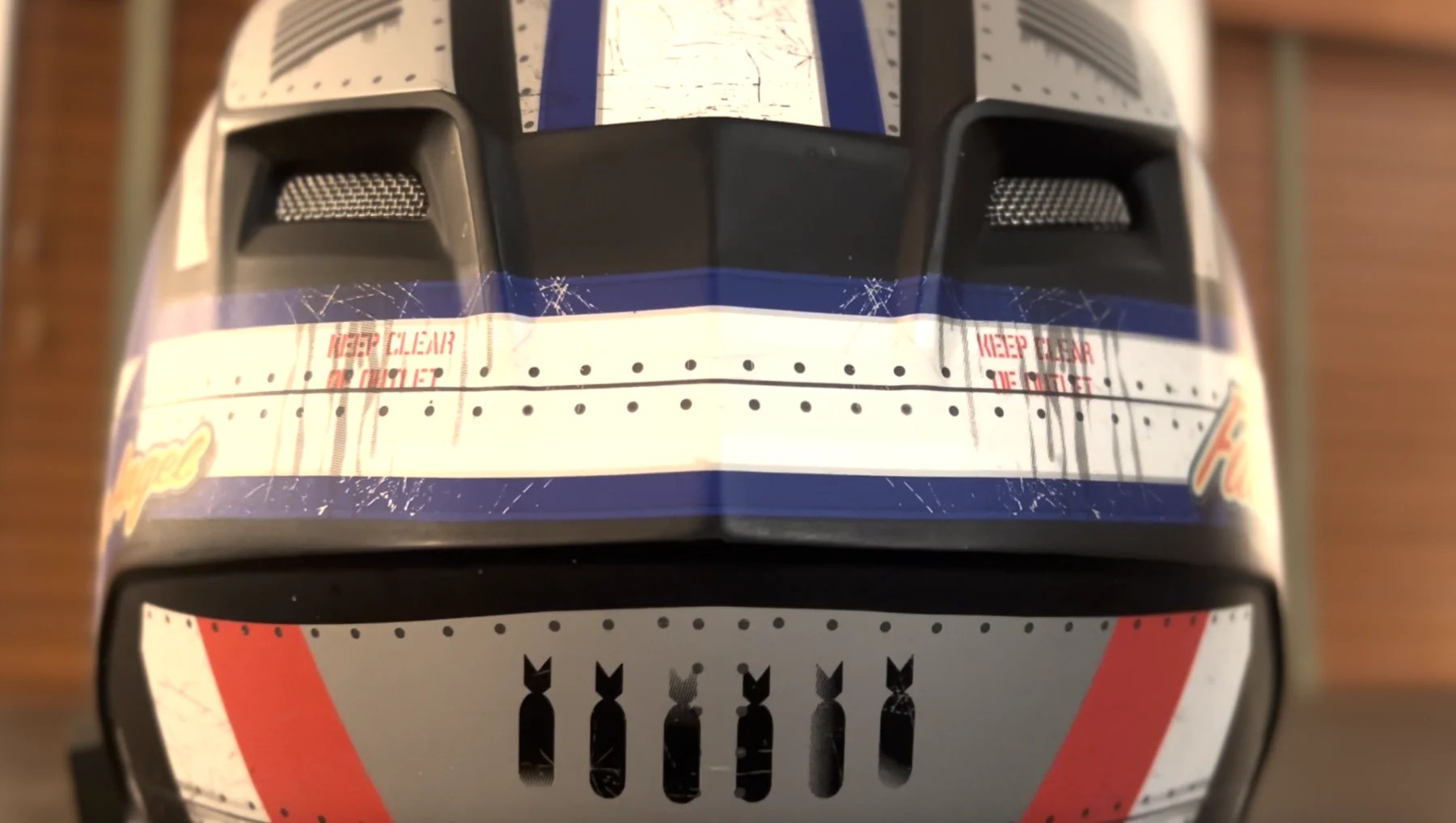
Visor & shield usability
Shoei’s CWR‑F2 shield offers optical clarity and features Vortex Generators along the edge to reduce turbulence. The first‑position venting system cracks the shield for defogging without letting in rain, and the shield can be swapped with other tinted versions (though there is no built‑in sun visor). A Pinlock Evo anti‑fog lens is included and installs easily. Riders like the positive detents and secure locking mechanism, though you must buy a separate tinted shield for bright conditions.
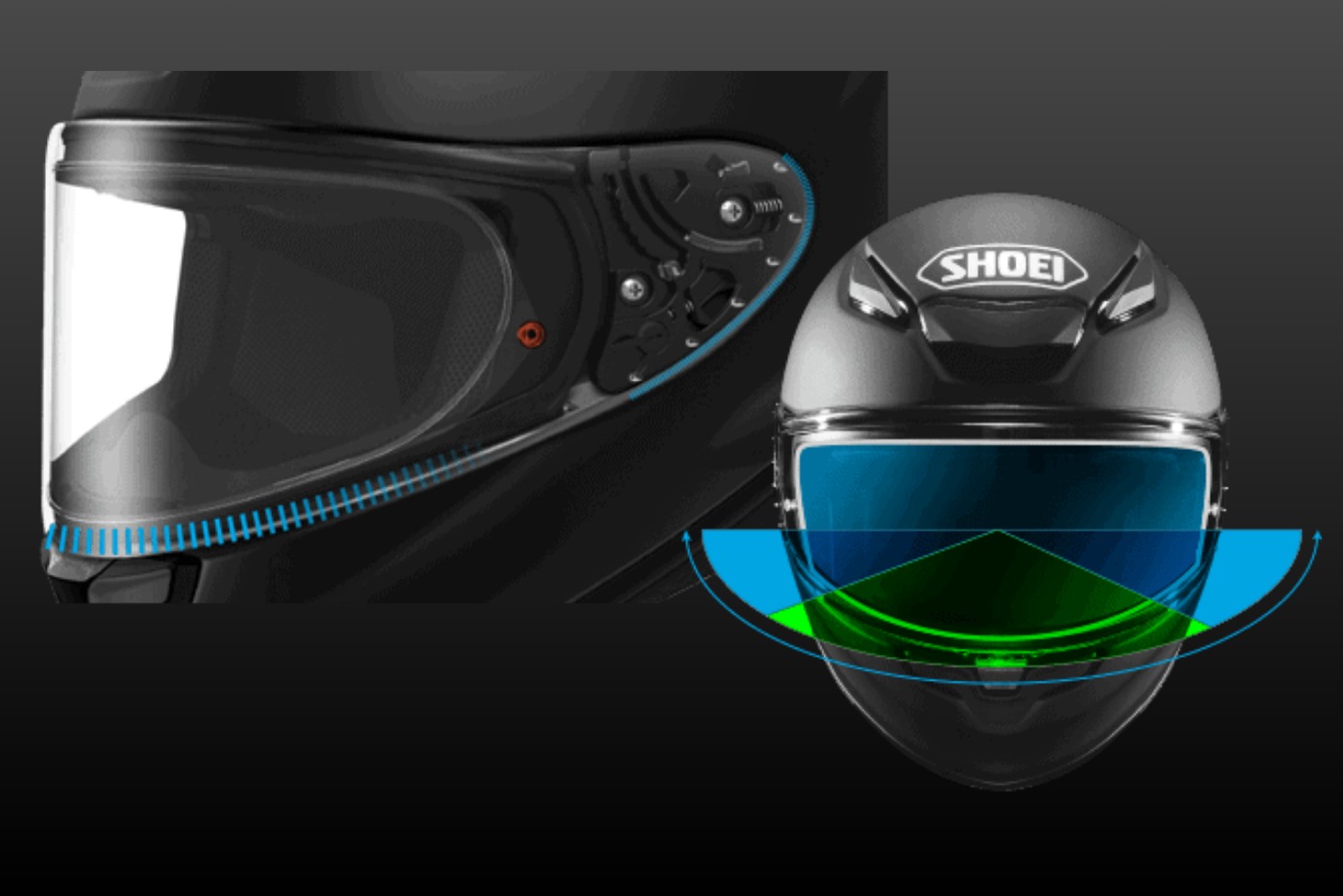
Bell ships the Qualifier DLX MIPS with its ProTint photochromic shield—arguably the helmet’s coolest feature. The shield darkens in sunlight and becomes clear at night, saving you from carrying extra visors. NutraFog II coating helps resist fogging, and Bell’s ClickRelease system allows tool‑free swaps. However, the shield’s scratch resistance isn’t great; both independent reviewers and our own testers note that the visor can scratch fairly easily if not handled carefully. After extended use, the spring mechanism that holds the shield taut can loosen—not a safety issue but a sign of less‑robust hardware compared with the Shoei’s steel‑on‑steel base plates.
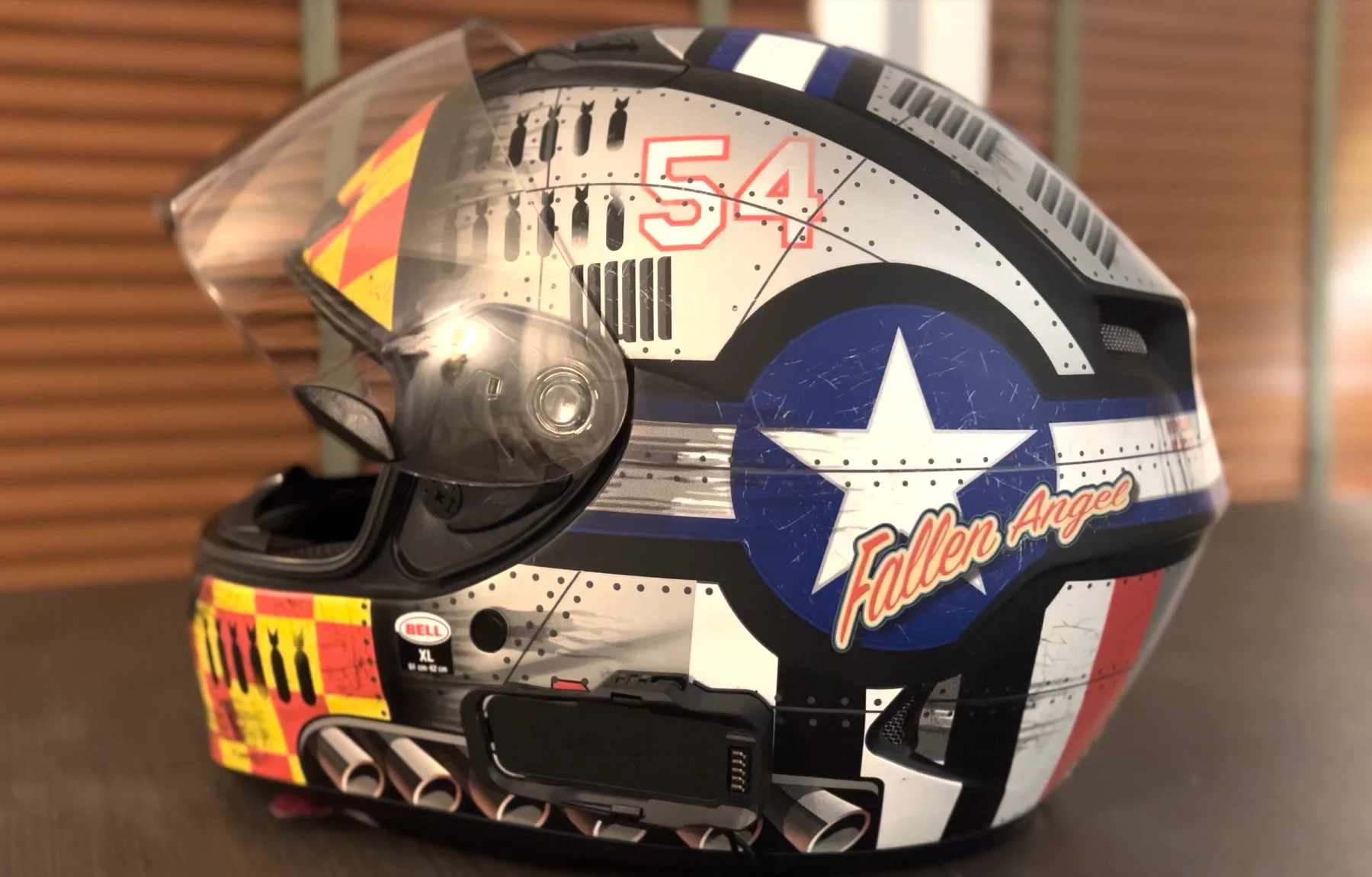
Communication device fitment
The RF‑1400 isn’t marketed as comms‑ready, but Shoei’s interior design lends itself to aftermarket Bluetooth units. The removable cheek pads and ear pads leave space for speakers, and the thick padding dampens noise while housing wires neatly. There are no dedicated wire channels; you need to route cables under the liner, but the process is straightforward for units like Sena 50S or Cardo Packtalk.
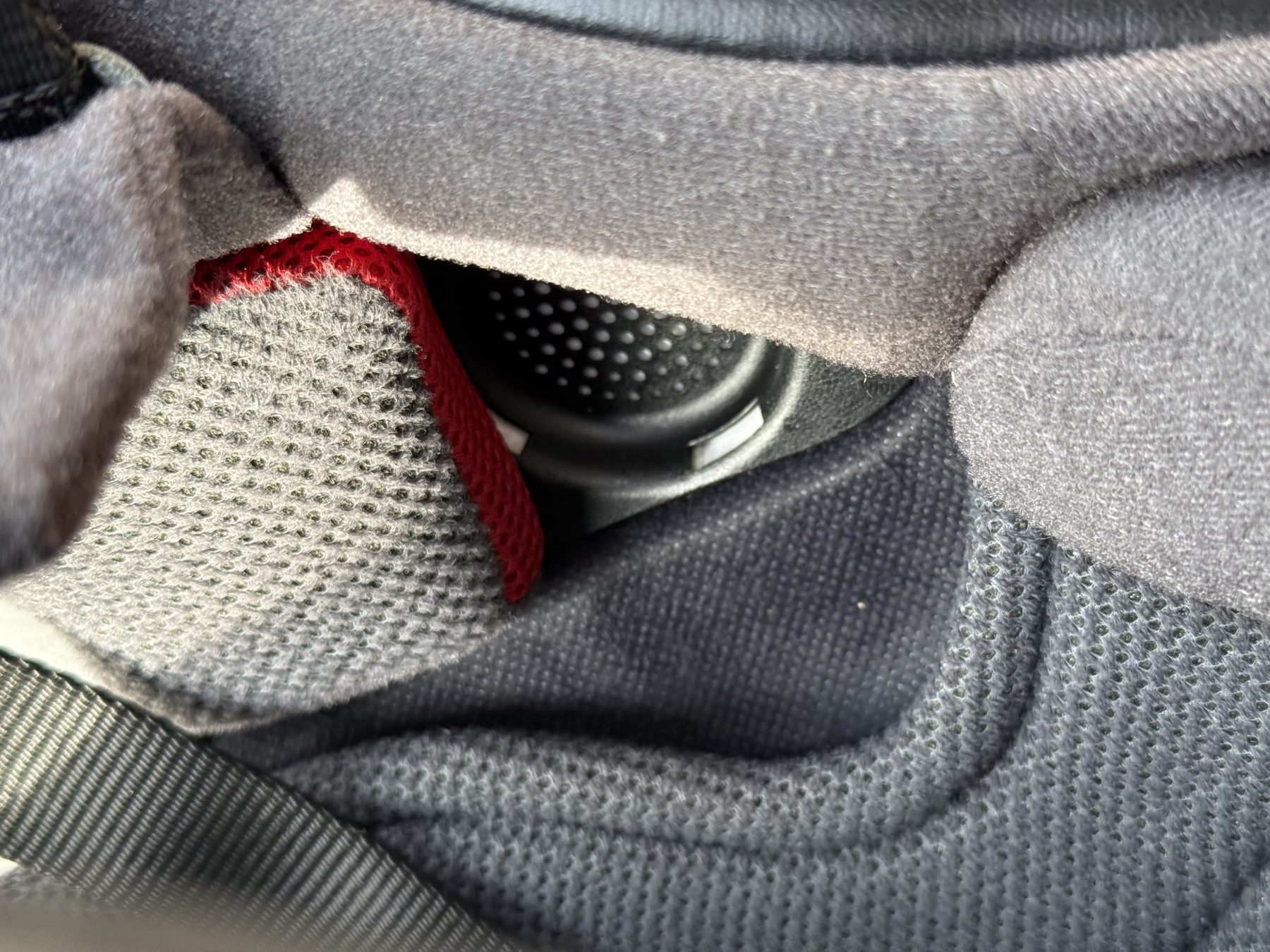
Bell designed the Qualifier DLX MIPS with integrated speaker pockets, making it easy to install popular intercoms such as Sena SMH10/10s or Cardo Q1/Q3. However, there are no dedicated wire channels, so you must tuck cables under the liner. The ear recesses are deep enough for most speakers, and the fit remains comfortable after installation. For riders who are new to communicators, the Bell’s pre‑formed pockets provide a simpler install than the Shoei.
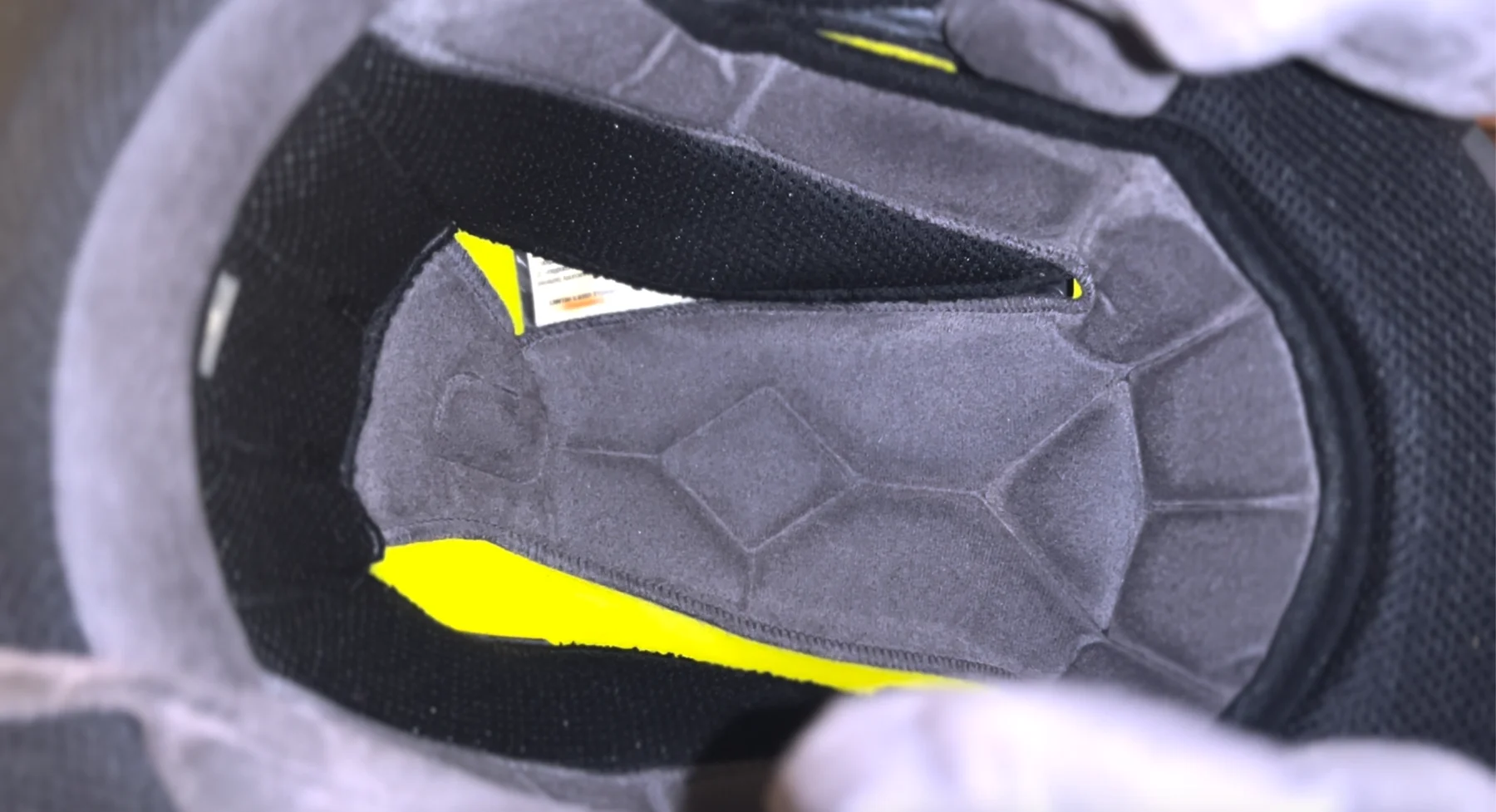
Build quality & finish
Shoei’s hand‑laid Multi‑Ply Matrix AIM+ shell combines layers of fiberglass and organic fibers. The finish, paint and graphics are first rate; after years of use, our reviewer reported no signs of delamination or hardware failure. The liner materials feel plush and wick sweat effectively; they’re completely removable and washable. Small touches like a ribbed shield tab, positive detents and a double‑D chin strap convey the premium build.
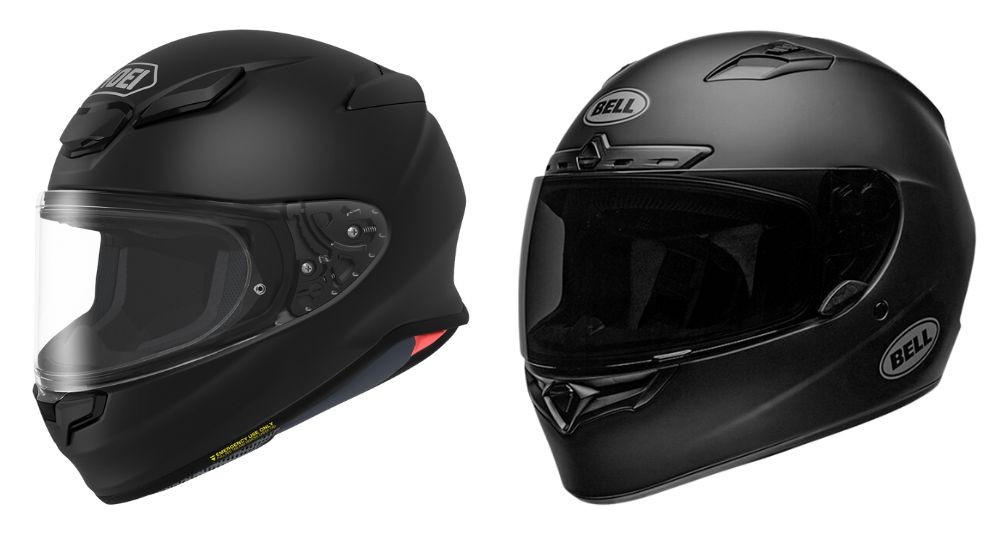
Bell’s polycarbonate shell and components are adequate for the price. Fit and finish are decent; the paint quality varies slightly among graphic options. The interior is moisture‑wicking and removable, but the fabric isn’t as plush as Shoei’s. Hardware like the shield springs and vent sliders feel less robust; after a year, one side of the visor can develop reduced tension. Still, for a sub‑$300 helmet, the build quality exceeds expectations and the five‑year warranty is reassuring.
Price vs. Perks: Is the Jump Worth It?
With a street price around $700, the RF‑1400 costs roughly $400 more than the Bell Qualifier DLX MIPS. What does that extra money buy?
- Superior materials & certifications. The Shoei’s Multi‑Ply Matrix AIM+ shell is stronger and lighter than polycarbonate. The helmet carries Snell M2020 certification, which requires more stringent impact tests than DOT or ECE alone.
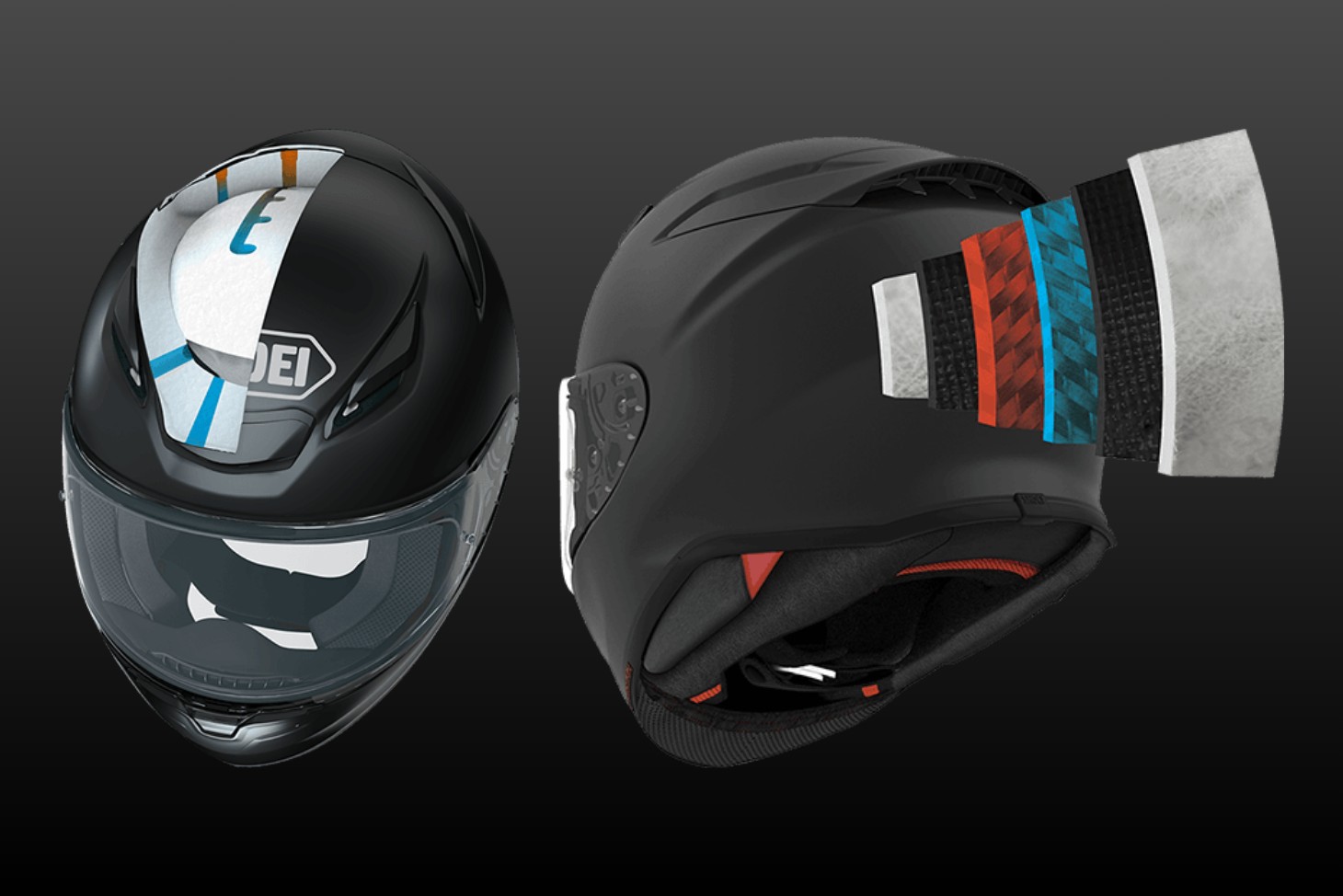
- Noise reduction. Shoei’s wind‑tunnel development, airtight seal and thick cheek pads result in a much quieter ride—particularly noticeable at highway speeds. For touring riders, less noise translates to less fatigue and better communication.
- More precise ventilation. The RF‑1400’s vents offer a wide range of adjustment and can be sealed completely. The Bell’s vents move more air but lack fine control and allow drafts in cold weather.
- Premium finish & longevity. Reviews of RF‑1400s that are four or more years old show minimal wear. The Bell’s visor mechanism and hardware may show wear sooner.
What do you give up by choosing the more affordable Bell?
- The ProTint shield is genuinely convenient. If you ride in varying light conditions and don’t want to purchase extra visors, this feature alone saves about $200 compared with buying a separate photochromic or smoked visor for the Shoei.
- MIPS technology offers an added layer of rotational‑impact protection that the Shoei lacks. While there’s debate about how much MIPS helps at motorcycle crash speeds, having additional safety features at this price point is attractive.
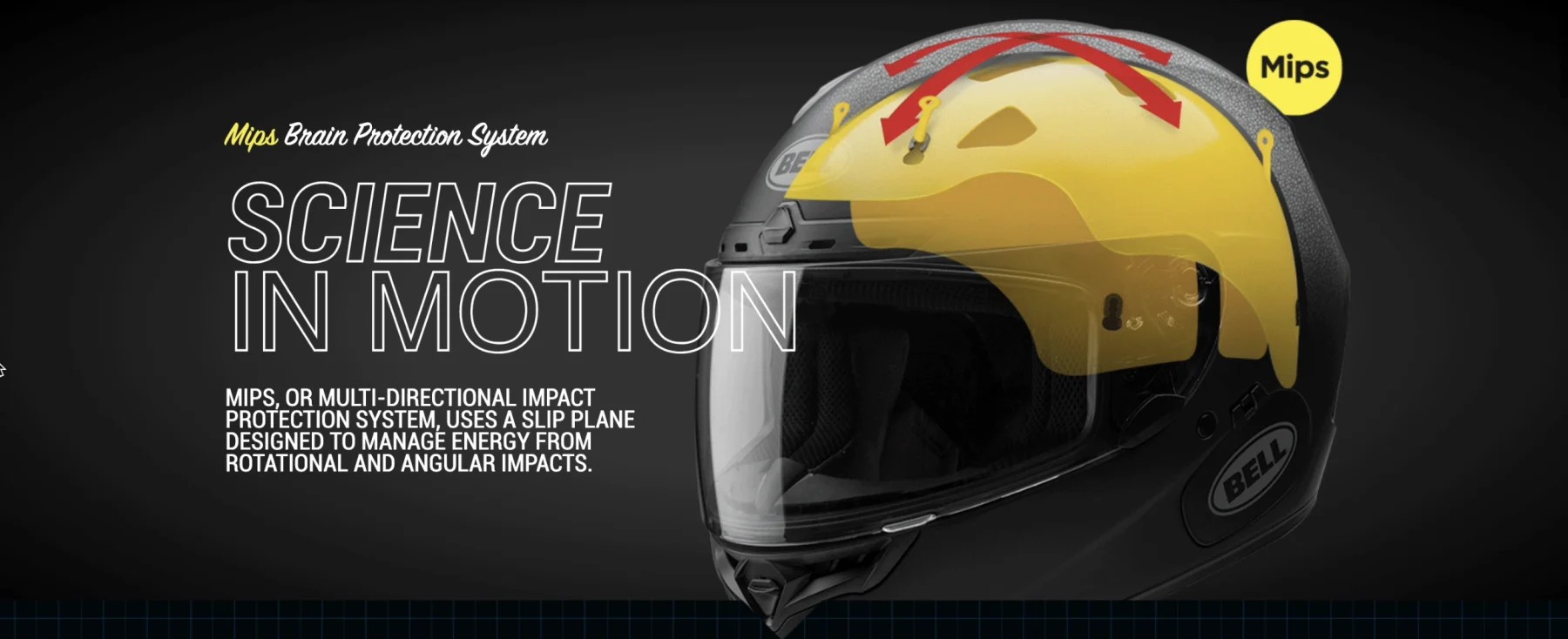
- You’ll need to accept higher noise levels and strong ventilation. If you ride in hot climates and wear earplugs anyway, the Bell might meet your needs at half the price.
In short, the Shoei RF‑1400 is the superior helmet in almost every performance metric—noise, ventilation control, safety certifications and finish. Riders who log thousands of miles yearly, ride at high speeds or prioritise long‑term durability will find the extra cost worthwhile.
The Bell Qualifier DLX MIPS offers exceptional feature‑per‑dollar value for commuters or occasional riders who want MIPS and a photochromic shield without spending premium‑helmet money.
Other Helmets Worth a Look
Shoei RF‑SR. A step down from the RF‑1400, the RF‑SR uses a similar AIM+ shell but lacks some of the RF‑1400’s noise‑reduction features. It’s quieter than most helmets in its price range and costs about $450–500. Ideal for riders who want Shoei quality without the top‑end price.
Evan rode in this helmet across America in 2022 and has worn it the tropical climate of Thailand as well. It's the ideal all-around street and touring helmet for a fair price: master of none, but great at everything. Read our long term review here.
- Sturdy build quality from the padding to the visor
- Composite AIM shell (not plastic / polycarbonate)
- Comfortable and snug liner
- Durable (I've battered the poor thing)
- Affordable 💵
ICON Airform MIPS. Another budget‑minded helmet with MIPS and aggressive styling. It’s slightly heavier than the Bell but offers quieter performance and more graphic options. A good option if noise bothers you and you still want MIPS.
AGV K6 S. For those willing to look beyond these two brands, AGV’s K6 S provides a carbon‑aramid shell, ECE 22.06 certification and extremely light weight (~2.95 lb) at around $500. It lacks a photochromic visor but offers superb comfort for sport‑touring riders.
A lightweight and aerodynamic helmet designed for ultimate comfort and protection, inspired by MotoGP technology.
- Ultra-light composite shell reduces fatigue
- 190° field of view enhances road awareness
- Aerodynamic design with low wind noise
- Excellent ventilation with multi-vent airflow
- Eyeglass-friendly interior and comms-ready
- Vent sliders can be fiddly with gloves
- Compact sizing—double-check shell fit
Looking for more options? See our best Shoei helmets guide or check out our best motorcycle helmets roundup for other picks in different price brackets.
Frequently Asked Questions
Is the Shoei RF‑1400 still one of the quietest helmets available?
Yes. Riders and reviewers consistently note that the RF‑1400 remains one of the quietest full‑face helmets you can buy. Its aerodynamic shell, Vortex Generator visor edges and improved seal keep wind noise low. Even at highway speeds, many riders use communications systems at moderate volume without wind interference.
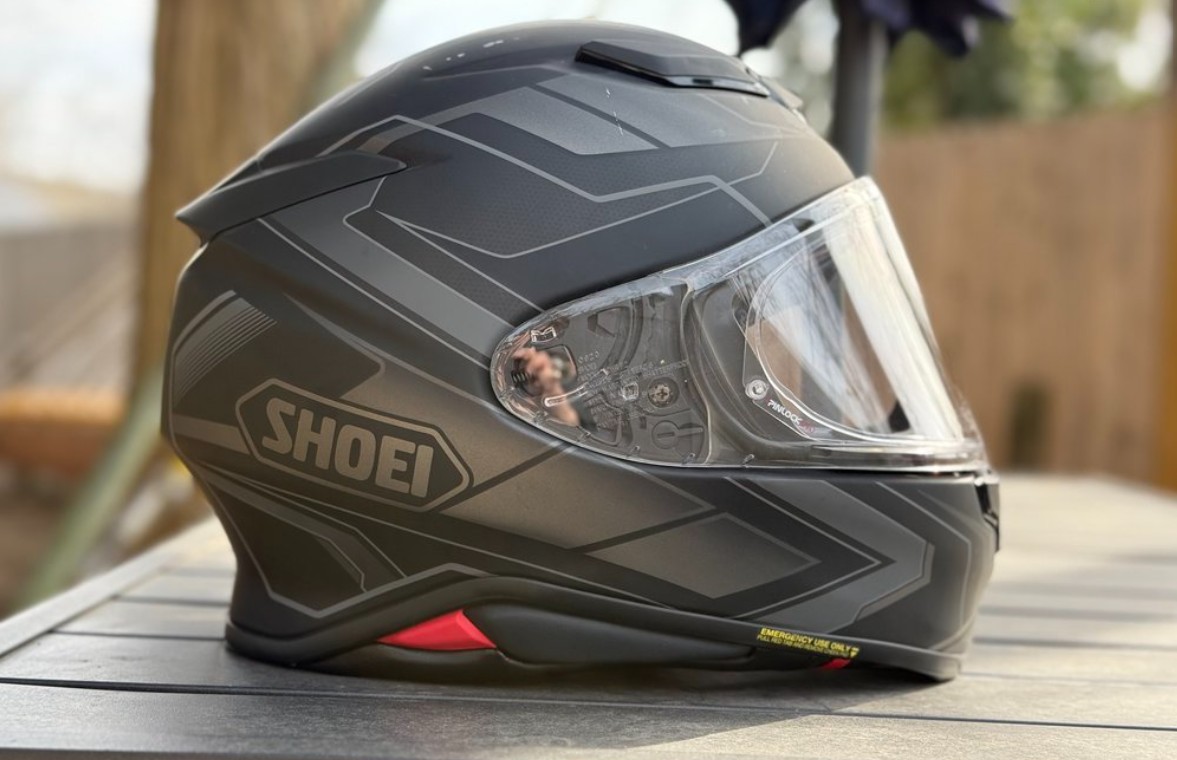
Does the Bell Qualifier DLX MIPS include Bluetooth?
No. The helmet has integrated speaker pockets for installing aftermarket intercoms, but it does not include a Bluetooth system. It is compatible with popular units such as Sena or Cardo; however, there are no dedicated wire channels, so you must tuck wires under the liner.
Can I use the Shoei’s Pinlock insert on the Bell helmet?
No. The Pinlock Evo insert included with the RF‑1400 is sized specifically for Shoei’s CWR‑F2 shield. The Bell helmet’s shield uses NutraFog II anti‑fog coating and does not have Pinlock posts. You could purchase a Pinlock‑equipped shield separately for the Bell, but the standard ProTint shield cannot accept Pinlock.
How long does the ProTint shield stay dark?
Bell’s ProTint shield darkens in bright sunlight and returns to clear in low light. Riders report that the transition occurs within seconds and does not affect visibility. The shield can scratch if you aren’t careful, so always store it in a soft bag and use mild soap and water for cleaning.
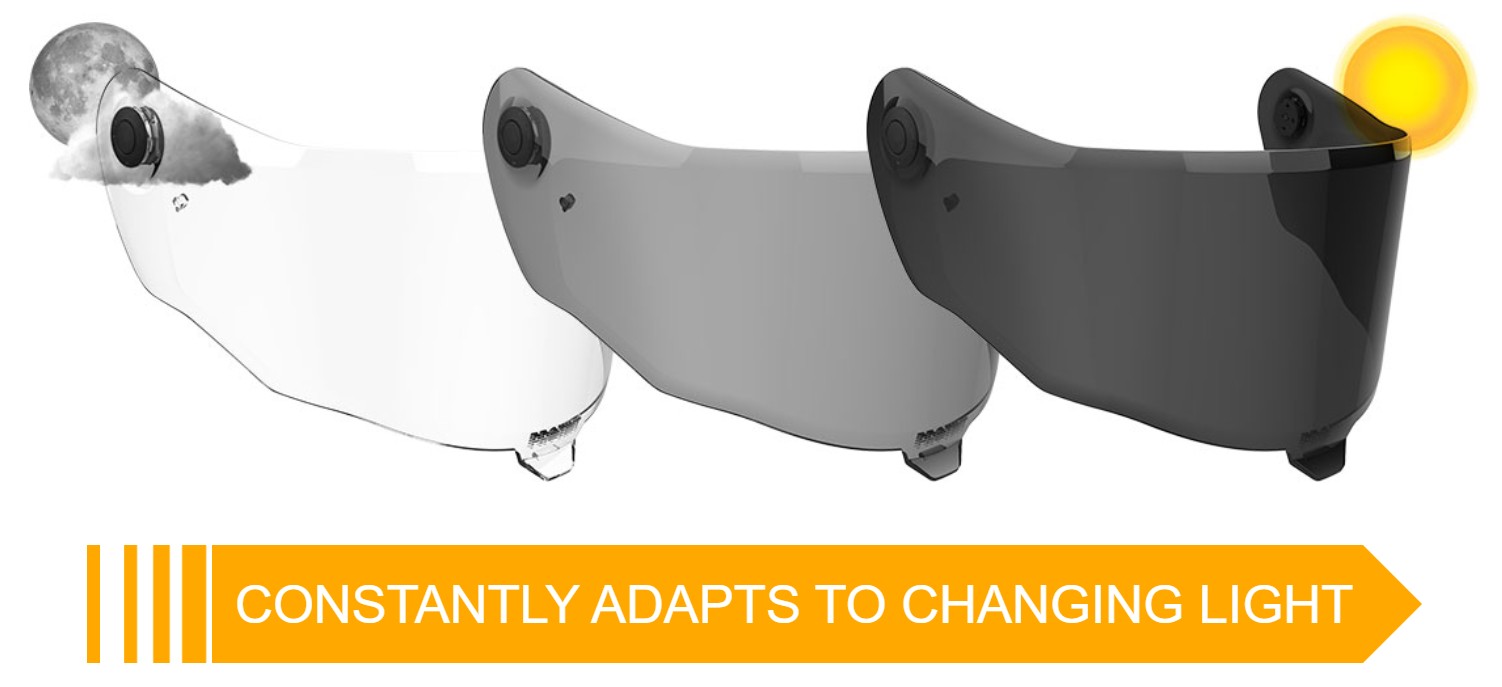
What head shapes do these helmets fit?
Both helmets fit an intermediate‑oval head shape. The Shoei comes in five shell sizes and fits true to size. It may feel snug initially but breaks in quickly. The Bell has three shell sizes and tends to run slightly small; if you’re between sizes, consider sizing up.
Will the Shoei’s lack of a sun visor be a problem?
It depends. If you ride frequently in bright sunlight, you’ll need to purchase a tinted or photochromic CWR‑F2 shield or wear sunglasses. Some riders prefer the Shoei’s simple visor system because there are fewer moving parts to fail. Others appreciate the convenience of the Bell’s ProTint shield. If you’re unwilling to swap shields, the Bell offers more out‑of‑the‑box versatility.
Wrapping Up…
At the end of the day, the Shoei RF-1400 is the helmet you buy if you crave quiet comfort mile after mile, while the Bell Qualifier DLX MIPS gives you modern safety and convenience without the premium price tag.
Whichever way you lean, you’ll be getting a helmet that’s earned its reputation on real riders’ heads, not just spec sheets.
One of the top motorcycle helmets for street riding due to its incredible safety ratings, solid build construction, versatile shell for street and track riding, and reasonable price. Long term review here. | With Mips force-reduction safety tech and a photochromatic visor that changes with the sun, this lid punches way above it's budget weight class. Review here. |
|
|
|
|
One of the top motorcycle helmets for street riding due to its incredible safety ratings, solid build construction, versatile shell for street and track riding, and reasonable price. Long term review here.
- Staff pick at Revzilla
- Excellent build quality
- Thick noise-sealing cheekpads
- Airtight visor seal
- Slightly snug out of the box—needs break-in
With Mips force-reduction safety tech and a photochromatic visor that changes with the sun, this lid punches way above it's budget weight class. Review here.
- Excellent airflow keeps you cool on hot rides
- MIPS adds enhanced rotational impact protection
- Photochromic visor adapts to changing light
- Comfortable liner, easy to wash and adjust
- Noticeable wind noise, especially above highway speeds
- Feels cold in low temps due to strong ventilation
Related

Carbon Fiber Modular Helmets: Ultimate Flip-Up Lids
Discover carbon fiber modular helmets that deliver flip-up convenience, lightweight strength, and serious protection for every ride.


